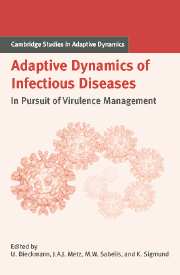Book contents
- Frontmatter
- Contents
- Contributing Authors
- List of Boxes
- Notational Standards
- 1 Introduction
- A Setting the Stage
- B Host Population Structure
- C Within-Host Interactions
- D Pathogen–Host Coevolution
- E Multilevel Selection
- F Vaccines and Drugs
- Introduction to Part F
- 23 Managing Antibiotic Resistance: What Models Tell Us?
- 24 Evolution of Vaccine-resistant Strains of Infectious Agents
- 25 Pathogen Evolution: The Case of Malaria
- 26 Vaccination and Serotype Replacement
- G Perspectives for Virulence Management
- References
- Index
- International Institute for Applied Systems Analysis
Introduction to Part F
Published online by Cambridge University Press: 15 January 2010
- Frontmatter
- Contents
- Contributing Authors
- List of Boxes
- Notational Standards
- 1 Introduction
- A Setting the Stage
- B Host Population Structure
- C Within-Host Interactions
- D Pathogen–Host Coevolution
- E Multilevel Selection
- F Vaccines and Drugs
- Introduction to Part F
- 23 Managing Antibiotic Resistance: What Models Tell Us?
- 24 Evolution of Vaccine-resistant Strains of Infectious Agents
- 25 Pathogen Evolution: The Case of Malaria
- 26 Vaccination and Serotype Replacement
- G Perspectives for Virulence Management
- References
- Index
- International Institute for Applied Systems Analysis
Summary
Evolutionary virulence management necessarily takes a long-term perspective and concentrates on population-level characteristics. Yet, in practice we also have to interfere with diseases on a short-term basis and, especially in the case of humans, the welfare of individual patients is an additional concern. This establishes the need to evaluate the longer-term effects of short-term protection measures. Only on this basis can we understand which compromises can be made or, even better, whether it is possible to devise practices that allow both satisfactory short-term and long-term disease control.
The main individual-level protection measures are drug treatment and vaccination. Both have consequences for public health by affecting the population dynamics of the disease, though in different manners: the former by shortening the infectious period, the latter by changing the inflow of fresh susceptible hosts. And both tend to have evolutionary consequences in terms of resistance evolution and vaccine escape.
After drug resistance develops, we are basically back at square one in terms of the control effort, since resistant types have at best a very slightly reduced fitness. If the drug-based selective regime is maintained long enough, resistant and nonresistant types even tend to become equally fit in a drug-free environment because of the incorporation of genetic modifiers.
In the case of drug resistance we appear to be rapidly running out of alternative options, whereas the prospects are considerably better for vaccination as, in principle, we can keep adapting the vaccine type.
- Type
- Chapter
- Information
- Adaptive Dynamics of Infectious DiseasesIn Pursuit of Virulence Management, pp. 324 - 325Publisher: Cambridge University PressPrint publication year: 2002



